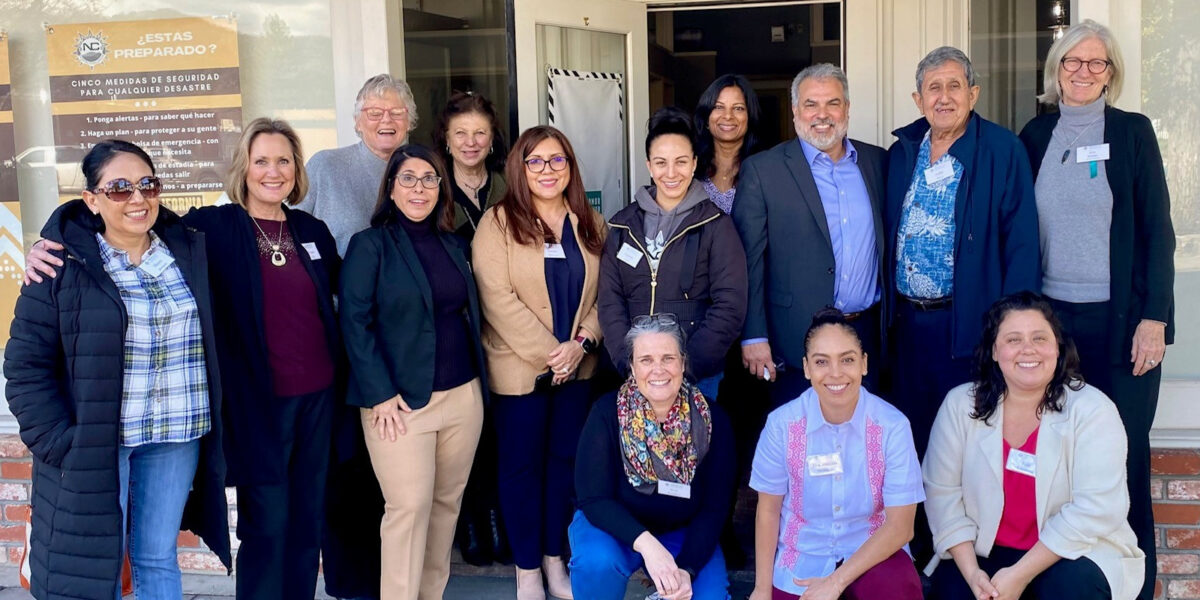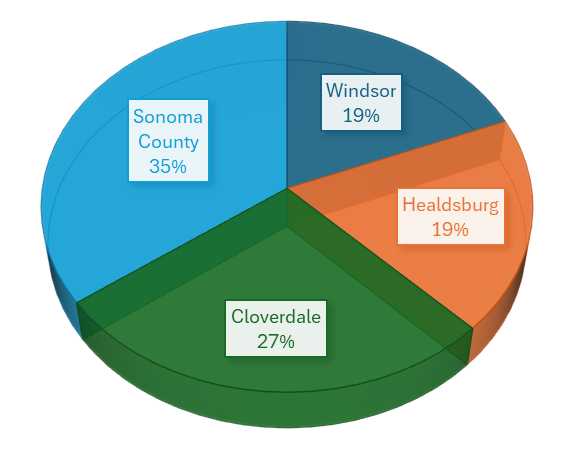

Reflections on the Healthcare Foundation’s Grant Distribution and Collaborative Role in Sonoma County
3 min read. Photo: Kick-off meeting for the Cloverdale ECO Group, February 2024. Back Row, L-R: Mayra Arreguin, La Familia Sana; Melanie Hall, Cloverdale Senior Center; Kirsten Tellez, Alexander Valley Healthcare; Alma Bowen, Nuestra Comunidad; Marrianne McBride, Council on Aging; Sandra Hoevertsz, Cloverdale Senior Center; Carmen Lara, Nuestra Comunidad; Dr. Sarita Mohanty and Rigo Saborio, The SCAN Foundation; Adam Meza, Community Member; Kim Bender, Healthcare Foundation Front Row, L-R: Erin Westphal, The SCAN Foundation; Dr. Daniela Dominguez, On the Margins; Jade Weymouth, La Familia Sana
Over the last four years, since 2020, the Healthcare Foundation has distributed just over $2.8M in grants to organizations throughout the region. We recently took a look at the breakdown of grants by geography: grants distributed to organizations located in northern Sonoma County, as well as distributions to partner organizations whose service areas may include northern Sonoma County, but who are located in Santa Rosa or elsewhere. When a grant to one of those organizations was specifically focused on a northern Sonoma County city, we associated those grant dollars with that city. Here is the percentage distribution of grants 2020–2024:

- Cloverdale 27%
- Healdsburg 19%
- Windsor 19%
- Sonoma County 35%
Cloverdale is both the most isolated city and has the highest needs, with a large percentage of farmworker residents and associated poverty, so it makes sense that almost one third of the Healthcare Foundation grants since 2020 ($788,258) has gone to organizations serving that area. Also not surprising is that the amount of grants distributed to Windsor ($540,125) and Healdsburg ($536,499) was nearly the same.
What did surprise us, however, though upon reflection makes sense, is the amount distributed to partner organizations located in other areas of Sonoma County, but whose services in most cases include Windsor, Healdsburg and Cloverdale ($1,003,429). We thought it worth tracing the history of the Healthcare Foundation’s role as a grantor in the county to better understand our grant distribution strategy.
The Healthcare Foundation was formed in 2001 to support the Healdsburg Hospital. Early on, however, the Healthcare Foundation board of directors chose to support other healthcare organizations in the area by making four general operating grants every year: one each to Alliance Medical Center, Alexander Valley Healthcare, Healdsburg Hospital, and Pediatric Dental Initiative. Three of those four organizations reside in northern Sonoma County, and one, PDI, is located in Santa Rosa and serves the entire county and beyond. This distribution represents the philosophy that stands today: our focus is on residents of northern Sonoma County, but we recognize that there are many nonprofits serving a wider region that deserve support, because often they are the only nonprofits in the county that provide that particular service.
In 2016, the Healthcare Foundation board decided to adjust course and focus more impactfully on the board’s research-based assessment of the greatest health needs: access to healthcare, mental health, and early childhood development. No sooner had the organization settled on those priorities, however, than the Tubbs Fire hit in 2017, and everything changed.
The devastation of the Tubbs Fire motivated individuals and organizations both within and outside Sonoma County to make one-time donations to the Healthcare Foundation, which significantly expanded our budget. This allowed the Healthcare Foundation to become a hub of vital collaborations throughout the county. While providing over $1M in grants in 2018, we solidified our role as a regional convener, collaborator and thought leader, particularly around mental health.
“There is no other funder in the county focused solely on health, healthcare and mental health. We occupy a unique position to seed innovative projects to address structural racism and discrimination linked to poor health outcomes for low-income people of color.”
Kim Bender, Executive Director
One-time, fire-related funding, for example, launched the Wildfire Mental Health Collaborative (WMHC), which provided Sonoma County organizations resources to address fire-related mental health issues, as well as train over 400 therapists from all over Northern California with Skills for Psychological Recovery (SPR). Also in 2018, we launched the Mental Health Talent Pipeline in response to the dire shortage of bilingual/bicultural providers in the area.
The WMHC funds wound down in 2020 just as the Covid pandemic hit, as we pivoted to respond to a new and unprecedented health emergency. The MHTP, meanwhile, has emerged as a sustainable program that addresses urgent mental health needs, not just caused by wildfires, but ongoing health stressors and the economic hardships that people throughout the county experience, particularly our low-income, Latine and Indigenous residents.
We are so proud that the MHTP continues to thrive, attract funding, and support new graduate students every year who agree to practice in northern Sonoma County. As mentioned above, to date we have supported 21 students to complete their degrees. Our current contract with USF, who splits the full-tuition scholarships with the Healthcare Foundation, extends to three more students who will enter the Masters in Counseling Psychology Program in 2024, and three more students in 2025. Additional funding means we can continue this program beyond 2025!
The impact of the MHTP cannot be overstated. By this time next year, over 3,000 unique individuals will have received 8-12 therapy sessions each from these trained, bilingual, bicultural therapists. Given the growing, post-pandemic mental health crisis and suicide rates for young Latine residents, this program is and will continue to be a top priority.
In addition to the MHTP, however, the Healthcare Foundation continues to develop its role as collaborator, convener and thought leader to increase health justice in Sonoma County. There is no other funder in the county who is focused solely on health, healthcare and mental health. We therefore occupy a unique position to seed innovative projects to address structural racism and discrimination that are linked to poor health outcomes for low-income people of color, our most underserved community. In order to address these structural issues and devise long-term solutions, we must reach beyond the geographic borders of northern Sonoma County and partner with organizations who share our values and provide complementary services to the population we all want to serve.
Thanks to your support over these many years, we are indeed making strides in bringing together individuals, nonprofits, and funders throughout the greater Sonoma County region who share a vision of health justice for all.

Related News + Stories
Invest in Our Community
Your support is vital to our collective vision of eliminating health inequities in northern Sonoma County.
Donate



